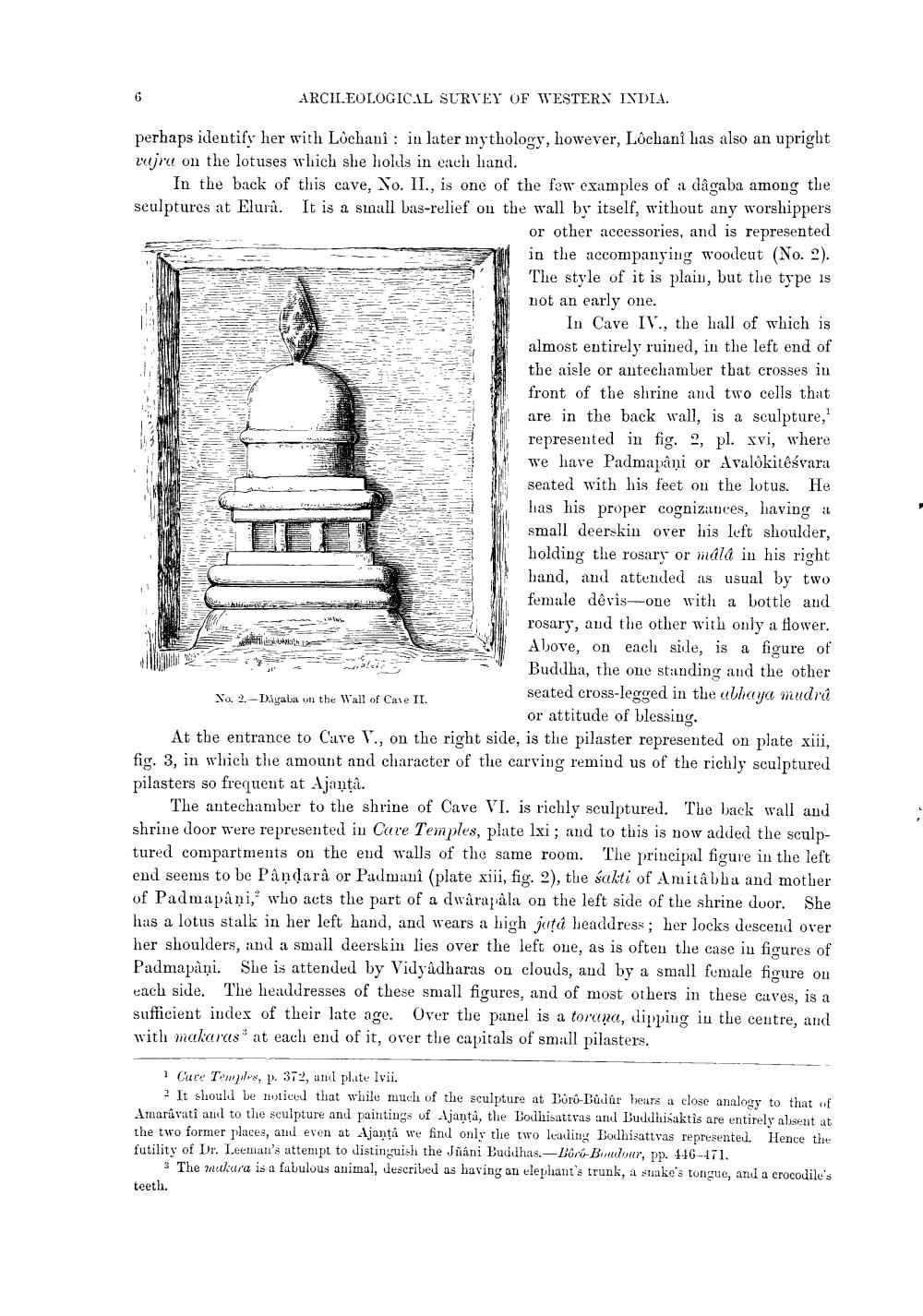________________
ARCH.EOLOGICAL SURVEY OF WESTERN INDIA.
WA
.
.
perhaps identify her with Lòchanî : in later mythology, however, Lóchani has also an upright wejra on the lotuses which she holds in each hand.
In the back of this cave, No. II., is one of the few examples of a dâgaba among the sculptures at Elurâ. It is a small bas-relief on the wall by itself, without any worshippers
or other accessories, and is represented in the accompanying woodeut (No. 2). The style of it is plain, but the type is not an early one.
In Cave IV., the hall of which is almost entirely ruined, in the left end of the aisle or antechamber that crosses in front of the shrine and two cells that are in the back wall, is a sculpture, represented in fig. 2, pl. xvi, where we have Padmapâni or Avalokitesvara seated with his feet on the lotus. He has his proper cognizances, having at small deerskin over his left shoulder, holding the rosary or målå in his right hand, and attended as usual by two female dêris--one with a bottle and rosary, and the other with only a flower. Above, on each side, is a figure of
Buddha, the one standing and the other Yo 2.-Diyata on the Wall of Case II.
seated cross-legged in the uthaya mudra
or attitude of blessing. At the entrance to Cave V., on the right side, is the pilaster represented on plate xiii, fig. 3, in which the amount and character of the carving remind us of the richly sculptured pilasters so frequent at Ajanta.
The antechamber to the shrine of Cave VI. is richly sculptured. The back wall and shrine door were represented in Cave Temples, plate lxi; and to this is now added the sculptured compartments on the end walls of the same room. The principal figure in the left end seems to be Pândarâ or Padmanî (plate xiii, fig. 2), the sakti of Amitabha and mother of Padma pâni, who acts the part of a dwarapala on the left side of the shrine door. She hus a lotus stalk in her left hand, and wears a high jatâ beaddress; her locks descend over her shoulders, and a small deersk in lies over the left one, as is often the case in figures of Padmapâni. She is attended by Vidyadharas on clouds, and by a small female figure ou each side. The headdresses of these small figures, and of most others in these caves, is a sufficient indes of their late age. Over the panel is a torana, dipping in the centre, and with makaras* at each end of it, over the capitals of small pilasters.
-
.
.
1 Cure Temp. 372, anl plate lvii.
? It should be noticed that while much of the sculpture at Büro-Bůdur hears a close analogy to that of Amaravati and to the sculpture and paintings of Ajantà, the Bodhisattvas and Buddhisaktis are entirely absent at the two former places, and even at Ajanta we find only the two leading Bodhisattvas represented. Hence the futility of Dr. Leeman's attempt to distinguish the Jñáni Buddhas.-Boro-Brdour, pp. 116-171.
9 The wukura is a fabulous animal, described as having an elephant's trunk, a snake's tongue, and a crocodile's teeth.




